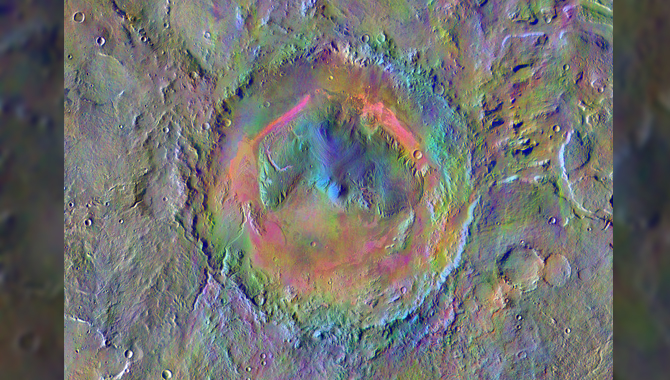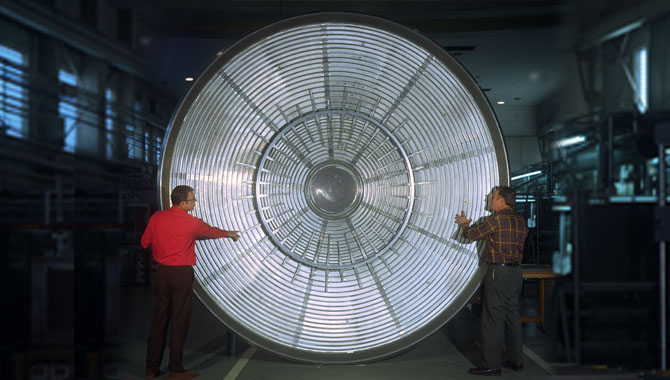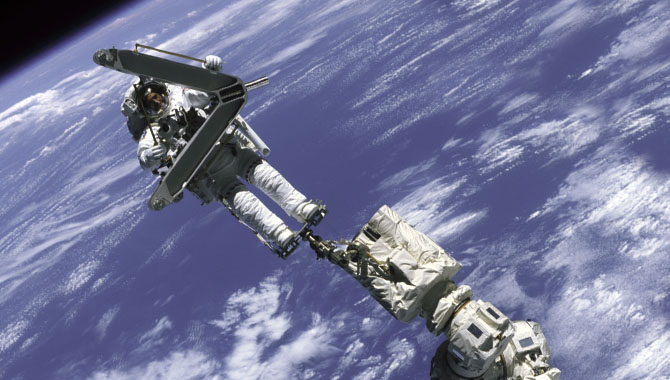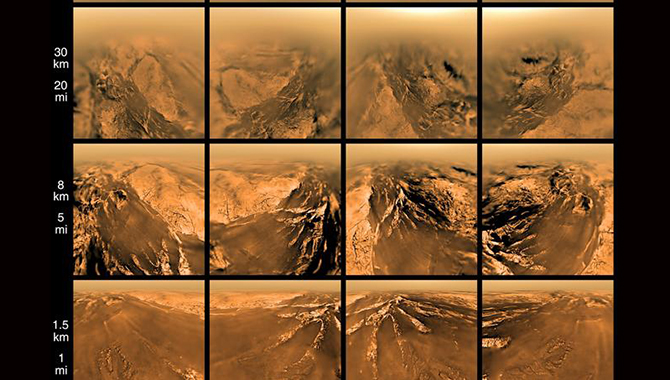
False-color image of Gale Crater based on data from Odyssey’s Thermal Emission Imaging System (THEMIS). The colors indicate different minerals in the martian surface.
Image Credit: NASA/JPL-Caltech/Arizona State University
Fifteen years ago this month, the 2001 Mars Odyssey launched from Cape Canaveral to become the longest-operating spacecraft around the red planet.
Named for a work of fiction—Arthur C. Clarke’s 2001: A Space Odyssey—the Odyssey has been on a series of fact-finding missions since leaving Earth on April 7, 2001. Over the course of its lifetime, Odyssey has offered scientists unique insight into the chemical and mineralogical makeup of the red planet, potential water sources, radiation levels, and climate. Some of this information is helping inform the design of future manned missions to Mars. Other data offers insight into the early history of Earth.
More than six months after launch, Odyssey reached Mars, where it fired its main engine for the first time. That burn, which lasted less than 20 minutes, positioned the spacecraft to begin the three-month process of reaching its operational orbit 250 miles above the planet. Odyssey employed a technique known as as aerobraking: it deliberately and repeatedly brushed against the top of the Martian atmosphere, using the resulting friction to reduce its speed without the need for additional fuel. In January 2002 Odyssey achieved its orbit and in February it began carrying out its science objectives.
To accomplish its goals, Odyssey was equipped with three instruments. The Thermal Emission Imaging System (THEMIS) and the Gamma Ray Spectrometer (GRS) focus on the surface and subsurface of Mars. Operating in both the visible and infrared parts of the electromagnetic spectrum, THEMIS characterizes the mineralogy of the soils and rocks of Mars. It can also detect “hot spots,” which may indicate the presence of underground hydrothermal systems. Meanwhile, the GRS works in the gamma ray part of the spectrum to map the elemental composition of the surface. The GRS has also measured the amount of hydrogen—which is associated with the presence of water—in the soil beneath the surface across the entire planet, information that may help eventual human visitors to Mars locate needed water sources. In addition, data from the GRS helped scientists determine the thickness of ice in the polar regions.
Odyssey’s third instrument, the Mars Radiation Environment Experiment (MARIE), concentrated its efforts off-planet by assessing the levels of radiation that astronauts traveling to and around Mars could experience. It determined that radiation levels around Mars are two to three times those around Earth. Eventually, when crewed missions take place, instruments similar to MARIE may help protect astronauts by detecting emissions of solar particles from the sun and providing notice so that crews can seek shelter. This could be critical to survival, as Mars lacks a magnetic shield to safeguard humans from galactic cosmic radiation.
Unlike THEMIS and the GRS, MARIE is no longer active. In the first years of the mission, the instrument failed twice. It was turned off in August 2001 when it didn’t respond during a downlink session. Seven months later, scientists turned it back on and it operated until an intense solar flare event occurred in October 2003, disabling the instrument. Despite numerous attempts to contact it, MARIE has not communicated with Earth since.
In addition to its science experiments, Odyssey has another important function. It supports communications between other Mars initiatives and Earth by serving as a relay for ground-based missions, such as the Spirit, Opportunity, and Curiosity rovers. With its larger antenna, Odyssey is able to send information to Earth quickly, which frees up the rovers to focus on collecting science. Odyssey also helps other missions by scouting potential landing sites as well as destinations for surface-based exploration.
Odyssey completed its primary mission in August 2004. It has since engaged in multiple extended missions. In December 2010, it became the longest-running operational spacecraft at Mars with 3,340 Earth days in orbit. Four and a half years later, in June 2015, Odyssey completed its 60,000th orbit around the red planet. A quality build, conservative fuel consumption, and continued careful handling have contributed to its longevity.
Over the course of its primary and extended missions, Odyssey mapped the entire surface of Mars, both during the day and at night. It discovered vast amounts of water ice below the surface of the planet. It observed the seasonal patterns of the planet, including the severe dust storms that occur periodically. It documented the flyby of comet Siding Spring, which passed quite close to the planet in 2014. In 2015, Odyssey’s orbit was adjusted so that it would fly over Mars in the early morning rather than late afternoon, allowing scientists to observe clouds, fogs, and frosts on the surface of the planet that generally aren’t present later in the day. With enough propellant to continue flying for close to another decade, Odyssey is expected to augment NASA’s understanding of Mars for years to come.
Odyssey is part of NASA’s Mars Exploration Program. It was built by Lockheed Martin and is managed by the Jet Propulsion Laboratory. The two organizations collaborate on mission operations. Arizona State University in Tempe provided and operates THEMIS. The GRS suite of instruments is managed by the University of Arizona.
Read an ASK Magazine interview with Jill Prince from Langley Research Center, who won a Women in Aerospace Achievement Award for her work on aerobraking, a technique employed by Odyssey to achieve its operational orbit around Mars.
Watch a video about how Odyssey was used to learn more about comet Siding Spring as it flew past Mars in October 2014.









